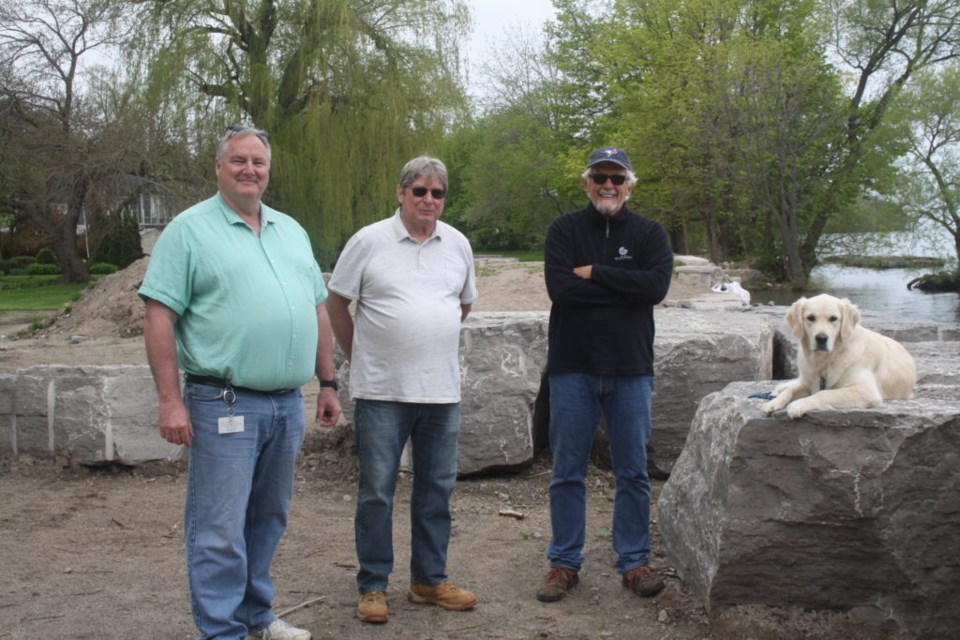
Last Friday afternoon, retired mining engineer Ron Simkus announced to his 100 or so email contacts, including Town staff and council, that according to the US Army Corps of Engineers, “we have officially reached the record level for Lake Ontario set back in May 2017,” 20 inches higher than this time last year and 31 inches over the long-term average.
Earlier in the day, the River Beach Drive resident said the lake was a touch lower than in 2017 — officially, three inches below the highest level — but that would change. And by afternoon, it had.
The question remains, how much further will it rise?
The charts for Lake Ontario “read like science fiction, numbers that nobody dreamed of predicting,” says Simkus.
Environment Canada data shows the lake has another 10 inches to go between now and mid-June.
He said he hopes the “worst case scenario” number is exaggerated, but if it holds true, “we will have to live through an extended period of high water that has never been experienced before. The summer storms will come and the waves with them. This is the biggest threat by far.”
Walking along the waterfront Friday, comparing notes with Brett Ruck, the Town’s environmental supervisor, Simkus said most home owners in the Dock Area did what they could to protect their properties during and after the 2017 flooding.
Ruck agreed. “Right now most people are feeling confident the shoreline protection we’ve done since then will do the rest of the work. We learned a lesson in 2017. But we can’t anticipate everything — there are so many variables.”
He said the Town is also better prepared now than it was two years ago, but hadn’t expected a repeat so quickly, or considered it could be worse.
“Now maybe we have to start thinking this is going to be the new norm, but what level do we protect it to?”
He said so far it’s been a matter of “educated guessing,” based on heavy snow melt and a lot of rain. “It’s always a combination of things. We can easily handle one issue or even two, but then you get a third thing thrown in and it’s a juggling act.”
They both agreed with levels predicted to be higher than they’ve ever seen, it’s difficult to gauge the impact.
A lot of what happens will depend on the wind, said Simkus — 90 per cent of waterfront damage occurs when the wind is from the east, but the wind only comes from the east about five per cent of the time.
However, also of concern is the prediction the lake will remain high until November. “The longer it takes to go up, the longer it takes to go down. There are an infinite number of variables as to what kind of storms we can have until then, and what they could do to us.”
Ruck was forthright about the value of the assistance Simkus is providing the Town.
“I’ve said openly I can’t do a better job,” said Ruck. “The time Ron spends on researching and gathering data, the level of detail he provides, the visual representations — it’s all invaluable.”
As of Friday, Ruck said, he was still running various modelling scenarios to determine what will happen if the water levels continue to rise as predicted.
“At that point we’ll have a better idea of what we’re looking, the impact it will have and what else we can do about it. You can’t address a problem until you know what it is.”
After that will come the action plan, but much of what can be done already has been done, he said.
And Simkus, after expressing some criticism of the Town’s efforts to stabilize the path along the waterfront recently, praised the work being done on shoreline stabilization. He believes NOTL is “leading the pack” compared to other municipalities, he said, although there is more work to be done, and quickly. He suggested any delay to getting armour stone in place for shoreline protection around the Dock Area parkette would mean extensive damage. As the lake level rises and the soil becomes saturated, heavy equipment working in the area “will tear it apart,” he warned.
In a recent email blitz, he said, “I want to let council know that although we appreciate and value your efforts in our district, we also recognize that the scope of this year’s shoreline challenge wraps all the way around NOTL, from Navy Hall to Port Weller. We are not alone.”